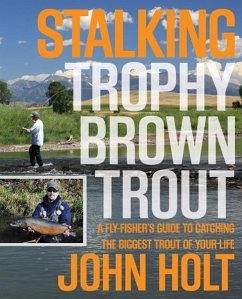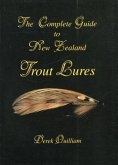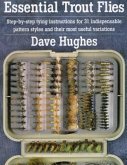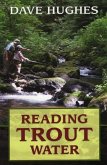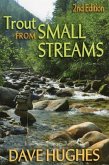- Broschiertes Buch
- Merkliste
- Auf die Merkliste
- Bewerten Bewerten
- Teilen
- Produkt teilen
- Produkterinnerung
- Produkterinnerung
From one of the most respected fishing writers in the country, this how-to guide will show every fly fisherman, from beginning to experienced, how to catch the biggest trout of his or her life.
Andere Kunden interessierten sich auch für
![Complete Guide to New Zealand Trout Lures Complete Guide to New Zealand Trout Lures]() Derek QuilliamComplete Guide to New Zealand Trout Lures24,99 €
Derek QuilliamComplete Guide to New Zealand Trout Lures24,99 €![The Trout Dreams The Trout Dreams]() Derek GrzelewskiThe Trout Dreams19,99 €
Derek GrzelewskiThe Trout Dreams19,99 €![Essential Trout Flies Essential Trout Flies]() Dave HughesEssential Trout Flies19,99 €
Dave HughesEssential Trout Flies19,99 €![Nymph-Fishing Rivers and Streams Nymph-Fishing Rivers and Streams]() Rick HafeleNymph-Fishing Rivers and Streams29,99 €
Rick HafeleNymph-Fishing Rivers and Streams29,99 €![Sight Fishing for Trout Sight Fishing for Trout]() Landon MayerSight Fishing for Trout22,99 €
Landon MayerSight Fishing for Trout22,99 €![Reading Trout Water Reading Trout Water]() Dave HughesReading Trout Water22,99 €
Dave HughesReading Trout Water22,99 €![Trout from Small Streams Trout from Small Streams]() Dave HughesTrout from Small Streams17,99 €
Dave HughesTrout from Small Streams17,99 €-
-
-
From one of the most respected fishing writers in the country, this how-to guide will show every fly fisherman, from beginning to experienced, how to catch the biggest trout of his or her life.
Produktdetails
- Produktdetails
- Verlag: Globe Pequot Publishing
- Seitenzahl: 200
- Erscheinungstermin: 17. Juli 2012
- Englisch
- Abmessung: 236mm x 191mm x 13mm
- Gewicht: 490g
- ISBN-13: 9780762773893
- ISBN-10: 0762773898
- Artikelnr.: 34566344
- Herstellerkennzeichnung
- Libri GmbH
- Europaallee 1
- 36244 Bad Hersfeld
- gpsr@libri.de
- Verlag: Globe Pequot Publishing
- Seitenzahl: 200
- Erscheinungstermin: 17. Juli 2012
- Englisch
- Abmessung: 236mm x 191mm x 13mm
- Gewicht: 490g
- ISBN-13: 9780762773893
- ISBN-10: 0762773898
- Artikelnr.: 34566344
- Herstellerkennzeichnung
- Libri GmbH
- Europaallee 1
- 36244 Bad Hersfeld
- gpsr@libri.de
John Holt is the author of thirteen published works of nonfiction, two short story collections, and a novel. His work has appeared in numerous magazines and newspapers including Fly Fisherman, The Denver Post, Sports Afield, Men’s Journal, Gray’s Sporting Journal, American Cowboy, Big Sky Journal, Fly Rod & Reel, Audubon, E, and Travel and Leisure.
Table of Contents
Chapter 1 – The Illusive, Predatory Nature of Browns – Why are browns so
difficult to catch, and why is hunting this voracious predator so rewarding
and exciting? Why are browns different from other trout? The classic,
crouching, quiet approach with lengthy leaders, tiny tippets, and long
casts is only rarely needed for browns. Big patterns, short stout leaders,
and loud, splashy casts tight to a bank or even onto the bank work better.
An angler needs to attract the attention of big fish that prefer undercut,
brushy banks, and shadowy lies.
Chapter 2 – The Surface Game – While only ten percent of a large trout's
feeding is on the surface, fishing dry flies or poppers can provide for a
disproportionate level of success. Even mouse and small frog imitations
will provoke heart-stopping attacks from very large fish. From the largest
patterns down to the smallest, the various flies and techniques will be
dissected and explained.
Chapter 3 – Lurking Just Below the Surface – For something completely
different, alarge, chartreuse, saltwater barracuda streamer can drive big
browns into a lunatic frenzy. This is shark hunting on the high plains. But
a more traditional, sedate approach is needed when the browns are feeding
on nymphs and emerging pupae just below the surface. Soft hackle patterns
like the Partridge-and-Orange cover lots of water easily and efficiently. I
explain my version of a technique first detailed by Jock Scott in Greased
Line Fishing For Salmon and refined by Sylvester Nemes.
Chapter 4 – Subterranean Excursions – Nymphing the classic Hare's Ear Nymph
along the bottom will take large browns even when little else works. I've
found that a pattern designed for lakes often is a killer on deep, smooth,
or even rapid stretches of rivers. The Bigg's Special imitates damsel and
dragon flies.
Chapter 5 – That Old Ace in the Hole – I've taken brown trout of five
pounds or more on a Cree Woolly Bugger that I designed years ago. I
describe in direct terms how to fish the bugger, either retrieved as fast
as possible, fished like a forage fish with a serious malfunction, or dead
drifted. Knowing when to use each a approach is the key. As an Alabama
tournament bass fisherman told me on the Missouri above Randall Dam,
“That's a real fine bugger you've got there. Make darn sure you fish it
like a minnow afeared for its life.”
Chapter 6 – Reading the Water – Most fly fishers believe that they are good
at determining where big browns hold. But prime locations are often not
what they seem, and not always evident at first glance. Pools, riffles, and
runs are all good, but how about shallow, still water among grass and
reeds, a la northern pike? Or how about working patterns along narrow,
lowering side channels that resemble the creeks of our childhoods? I call
this “Toy Creek Fishing.”
Chapter 7 – Final Thoughts – A summation with a few last tips, I'll discuss
seasonal and daily timing, fishing rivers as they compress after spring
runoff, and how to take the information in this book and use it for other
trout species, along with bass and northern pike.
Further Reading – This will be a thorough and at times esoteric list and
description of the titles referenced in this book.
Notes – Required tackle, terminal gear and fly tying instructions will be
included at the end of each chapter. In addition to what to do, each
chapter will also describe what not to do when fishing for big browns.
Chapter 1 – The Illusive, Predatory Nature of Browns – Why are browns so
difficult to catch, and why is hunting this voracious predator so rewarding
and exciting? Why are browns different from other trout? The classic,
crouching, quiet approach with lengthy leaders, tiny tippets, and long
casts is only rarely needed for browns. Big patterns, short stout leaders,
and loud, splashy casts tight to a bank or even onto the bank work better.
An angler needs to attract the attention of big fish that prefer undercut,
brushy banks, and shadowy lies.
Chapter 2 – The Surface Game – While only ten percent of a large trout's
feeding is on the surface, fishing dry flies or poppers can provide for a
disproportionate level of success. Even mouse and small frog imitations
will provoke heart-stopping attacks from very large fish. From the largest
patterns down to the smallest, the various flies and techniques will be
dissected and explained.
Chapter 3 – Lurking Just Below the Surface – For something completely
different, alarge, chartreuse, saltwater barracuda streamer can drive big
browns into a lunatic frenzy. This is shark hunting on the high plains. But
a more traditional, sedate approach is needed when the browns are feeding
on nymphs and emerging pupae just below the surface. Soft hackle patterns
like the Partridge-and-Orange cover lots of water easily and efficiently. I
explain my version of a technique first detailed by Jock Scott in Greased
Line Fishing For Salmon and refined by Sylvester Nemes.
Chapter 4 – Subterranean Excursions – Nymphing the classic Hare's Ear Nymph
along the bottom will take large browns even when little else works. I've
found that a pattern designed for lakes often is a killer on deep, smooth,
or even rapid stretches of rivers. The Bigg's Special imitates damsel and
dragon flies.
Chapter 5 – That Old Ace in the Hole – I've taken brown trout of five
pounds or more on a Cree Woolly Bugger that I designed years ago. I
describe in direct terms how to fish the bugger, either retrieved as fast
as possible, fished like a forage fish with a serious malfunction, or dead
drifted. Knowing when to use each a approach is the key. As an Alabama
tournament bass fisherman told me on the Missouri above Randall Dam,
“That's a real fine bugger you've got there. Make darn sure you fish it
like a minnow afeared for its life.”
Chapter 6 – Reading the Water – Most fly fishers believe that they are good
at determining where big browns hold. But prime locations are often not
what they seem, and not always evident at first glance. Pools, riffles, and
runs are all good, but how about shallow, still water among grass and
reeds, a la northern pike? Or how about working patterns along narrow,
lowering side channels that resemble the creeks of our childhoods? I call
this “Toy Creek Fishing.”
Chapter 7 – Final Thoughts – A summation with a few last tips, I'll discuss
seasonal and daily timing, fishing rivers as they compress after spring
runoff, and how to take the information in this book and use it for other
trout species, along with bass and northern pike.
Further Reading – This will be a thorough and at times esoteric list and
description of the titles referenced in this book.
Notes – Required tackle, terminal gear and fly tying instructions will be
included at the end of each chapter. In addition to what to do, each
chapter will also describe what not to do when fishing for big browns.
Table of Contents
Chapter 1 – The Illusive, Predatory Nature of Browns – Why are browns so
difficult to catch, and why is hunting this voracious predator so rewarding
and exciting? Why are browns different from other trout? The classic,
crouching, quiet approach with lengthy leaders, tiny tippets, and long
casts is only rarely needed for browns. Big patterns, short stout leaders,
and loud, splashy casts tight to a bank or even onto the bank work better.
An angler needs to attract the attention of big fish that prefer undercut,
brushy banks, and shadowy lies.
Chapter 2 – The Surface Game – While only ten percent of a large trout's
feeding is on the surface, fishing dry flies or poppers can provide for a
disproportionate level of success. Even mouse and small frog imitations
will provoke heart-stopping attacks from very large fish. From the largest
patterns down to the smallest, the various flies and techniques will be
dissected and explained.
Chapter 3 – Lurking Just Below the Surface – For something completely
different, alarge, chartreuse, saltwater barracuda streamer can drive big
browns into a lunatic frenzy. This is shark hunting on the high plains. But
a more traditional, sedate approach is needed when the browns are feeding
on nymphs and emerging pupae just below the surface. Soft hackle patterns
like the Partridge-and-Orange cover lots of water easily and efficiently. I
explain my version of a technique first detailed by Jock Scott in Greased
Line Fishing For Salmon and refined by Sylvester Nemes.
Chapter 4 – Subterranean Excursions – Nymphing the classic Hare's Ear Nymph
along the bottom will take large browns even when little else works. I've
found that a pattern designed for lakes often is a killer on deep, smooth,
or even rapid stretches of rivers. The Bigg's Special imitates damsel and
dragon flies.
Chapter 5 – That Old Ace in the Hole – I've taken brown trout of five
pounds or more on a Cree Woolly Bugger that I designed years ago. I
describe in direct terms how to fish the bugger, either retrieved as fast
as possible, fished like a forage fish with a serious malfunction, or dead
drifted. Knowing when to use each a approach is the key. As an Alabama
tournament bass fisherman told me on the Missouri above Randall Dam,
“That's a real fine bugger you've got there. Make darn sure you fish it
like a minnow afeared for its life.”
Chapter 6 – Reading the Water – Most fly fishers believe that they are good
at determining where big browns hold. But prime locations are often not
what they seem, and not always evident at first glance. Pools, riffles, and
runs are all good, but how about shallow, still water among grass and
reeds, a la northern pike? Or how about working patterns along narrow,
lowering side channels that resemble the creeks of our childhoods? I call
this “Toy Creek Fishing.”
Chapter 7 – Final Thoughts – A summation with a few last tips, I'll discuss
seasonal and daily timing, fishing rivers as they compress after spring
runoff, and how to take the information in this book and use it for other
trout species, along with bass and northern pike.
Further Reading – This will be a thorough and at times esoteric list and
description of the titles referenced in this book.
Notes – Required tackle, terminal gear and fly tying instructions will be
included at the end of each chapter. In addition to what to do, each
chapter will also describe what not to do when fishing for big browns.
Chapter 1 – The Illusive, Predatory Nature of Browns – Why are browns so
difficult to catch, and why is hunting this voracious predator so rewarding
and exciting? Why are browns different from other trout? The classic,
crouching, quiet approach with lengthy leaders, tiny tippets, and long
casts is only rarely needed for browns. Big patterns, short stout leaders,
and loud, splashy casts tight to a bank or even onto the bank work better.
An angler needs to attract the attention of big fish that prefer undercut,
brushy banks, and shadowy lies.
Chapter 2 – The Surface Game – While only ten percent of a large trout's
feeding is on the surface, fishing dry flies or poppers can provide for a
disproportionate level of success. Even mouse and small frog imitations
will provoke heart-stopping attacks from very large fish. From the largest
patterns down to the smallest, the various flies and techniques will be
dissected and explained.
Chapter 3 – Lurking Just Below the Surface – For something completely
different, alarge, chartreuse, saltwater barracuda streamer can drive big
browns into a lunatic frenzy. This is shark hunting on the high plains. But
a more traditional, sedate approach is needed when the browns are feeding
on nymphs and emerging pupae just below the surface. Soft hackle patterns
like the Partridge-and-Orange cover lots of water easily and efficiently. I
explain my version of a technique first detailed by Jock Scott in Greased
Line Fishing For Salmon and refined by Sylvester Nemes.
Chapter 4 – Subterranean Excursions – Nymphing the classic Hare's Ear Nymph
along the bottom will take large browns even when little else works. I've
found that a pattern designed for lakes often is a killer on deep, smooth,
or even rapid stretches of rivers. The Bigg's Special imitates damsel and
dragon flies.
Chapter 5 – That Old Ace in the Hole – I've taken brown trout of five
pounds or more on a Cree Woolly Bugger that I designed years ago. I
describe in direct terms how to fish the bugger, either retrieved as fast
as possible, fished like a forage fish with a serious malfunction, or dead
drifted. Knowing when to use each a approach is the key. As an Alabama
tournament bass fisherman told me on the Missouri above Randall Dam,
“That's a real fine bugger you've got there. Make darn sure you fish it
like a minnow afeared for its life.”
Chapter 6 – Reading the Water – Most fly fishers believe that they are good
at determining where big browns hold. But prime locations are often not
what they seem, and not always evident at first glance. Pools, riffles, and
runs are all good, but how about shallow, still water among grass and
reeds, a la northern pike? Or how about working patterns along narrow,
lowering side channels that resemble the creeks of our childhoods? I call
this “Toy Creek Fishing.”
Chapter 7 – Final Thoughts – A summation with a few last tips, I'll discuss
seasonal and daily timing, fishing rivers as they compress after spring
runoff, and how to take the information in this book and use it for other
trout species, along with bass and northern pike.
Further Reading – This will be a thorough and at times esoteric list and
description of the titles referenced in this book.
Notes – Required tackle, terminal gear and fly tying instructions will be
included at the end of each chapter. In addition to what to do, each
chapter will also describe what not to do when fishing for big browns.

